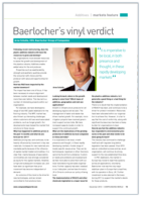Interviews
15.12.2010
Interview mit CEO Arne Schulle
Baerlocher’s vinyl verdict
Arne Schulle, CEO, Baerlocher Group of Companies
Following recent restructuring, does the plastic additives industry still have the resources to grow and develop?
Yes, organisations must allocate resources to assist the growth and development of the plastics industry. Additives enable added value for the end producer.
Properties such as weatherability, strength and aesthetic qualities provide the consumer with choice and the producer with value and opportunities for growth.How has R&D been impacted by the market downturn?
The impact has been one of focus. It has been necessary to ensure alignment between market needs and development more than ever before. This has led to a number of interesting projects within our organisation. For example, we have developed a range of low-VOC paste stabilizers for the flooring industry. The WPC market has also thrown up interesting challenges where customers still see wood associated problems, such as fungal growth. Our developments have helped the market find solutions to these issues.What has happened to additives prices in the past 12 months and what do you forecast for 2011?
Additives pricing has, and continues, to be heavily influenced by movement in key raw materials. Increases for raw materials are inevitable partly because of the influence of capital market traded commodities. It is clear that, mainly because of speculation, commodities are now strongly considered as equity for the capital markets. Volatility is high and subsequent increases can, and have been so significant that price movement has become independent of demand.
An outcome of this trend is the drive for new technologies, and we remain committed to find solutions here.
Looking forward, where is the growth going to come from? Which types of additives, geographies and end-use applications?
Growth in infrastructure products for all developing regions will be seen. The management of water and waste has driven market growth. For example, micro irrigation projects have received government support across India. We have increased capacity locally in order to support this continued growth.
What are the implications of the growing production of additives by local companies in China and India?
It is imperative to be local, in both presence and thought, in these rapidly developing markets. A wide range of locally specific issues arise. They can be technological, logistical or other. Solutions cannot be found from a distance. Customer needs and problems are localised and we feel more able to solve them with our local manufacturing and sales organisations. Further capacity has been installed in our India plant, and we have formed a JV in China to continue our policy of being local. The implementation of REACH and other chemicals legislation is a major issue for the plastics additives industry. Is it generally a good thing or a bad thing for the industry?
There is no doubt that the implementation of REACH has been, and continues to be a driver for product innovation. Resources have been allocated within our organisation to achieve this. However, it is fair to say that the cost of conformity, along with significant bureaucracy has been a heavy burden for organisations to bear. How do you feel the additives industry has responded to environmental pressures in the past and what needs to be done going forward?
The industry has continued to challenge itself and self-regulate long before legislation has been passed. Vinyl 2010 was an undoubted success and we, as an organisation, will continue its strong support to the now established Vinyl plus.
In PVC stabilizers, the market in Europe has moved to lead-free systems across all applications, voluntarily. Baerlocher now has the only major stabilizer plant in Europe that is lead free, with its operation in Bury, UK. Further investment is also planned in Germany during 2011 to support the market’s desire for these products.



